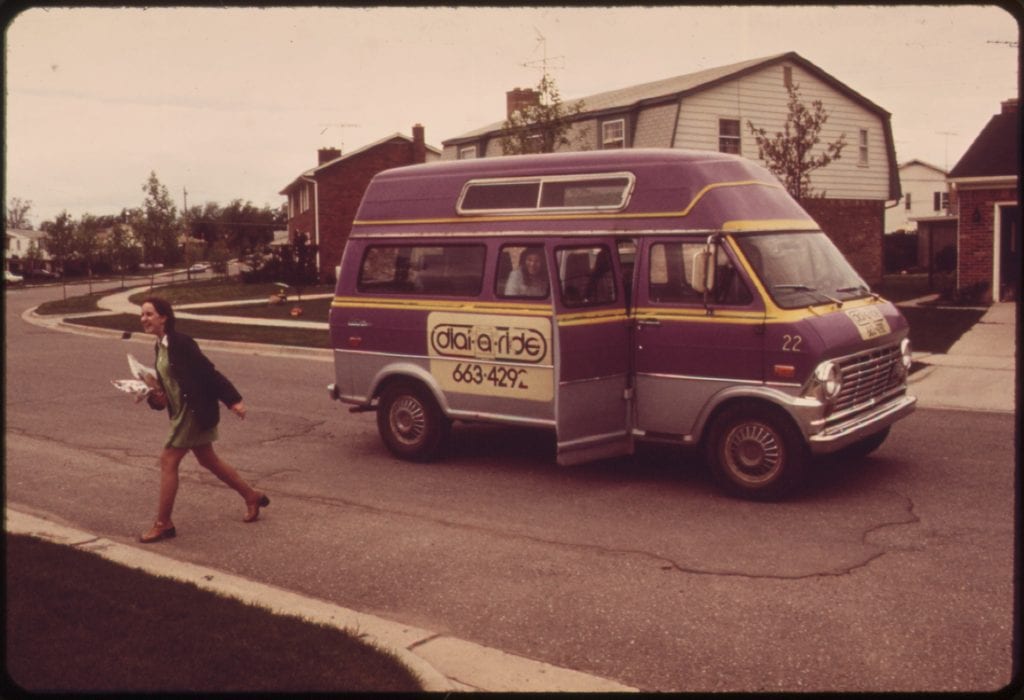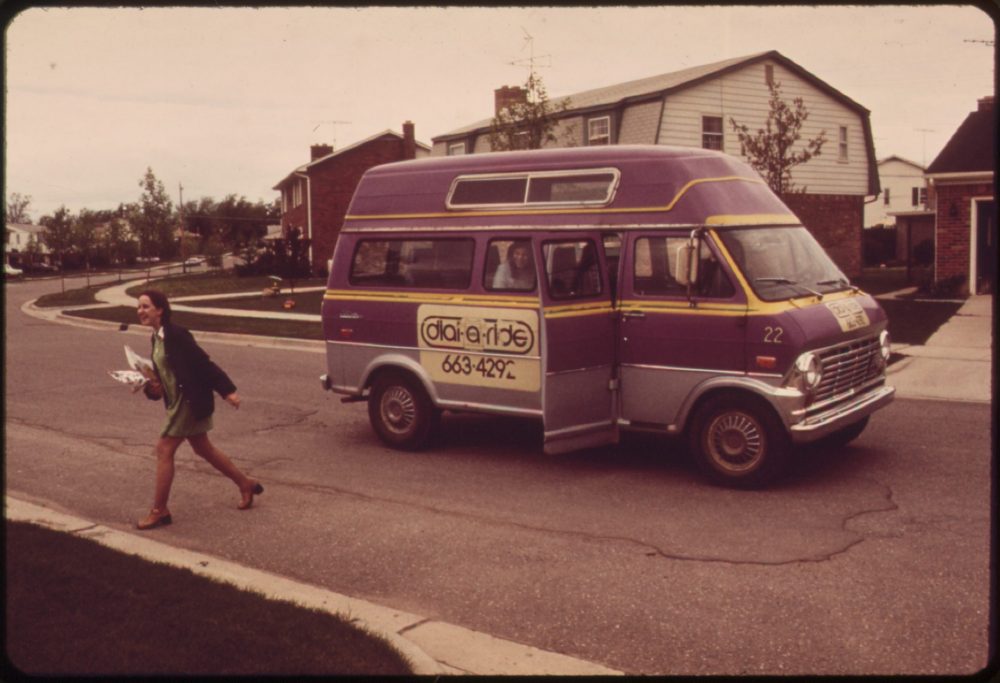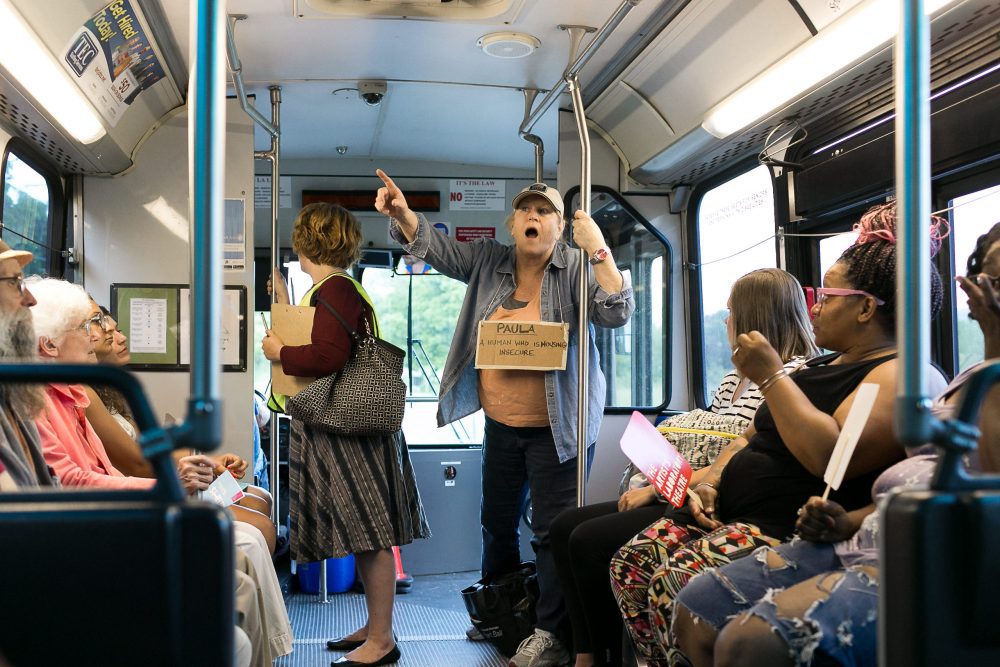
A passenger is dropped off by a dial-a-ride service in Ann Arbor, Michigan, in 1973. Photo by Joe Clark via Wikimedia
“Shared mobility.” “Microtransit.” With the rise of ride-hailing services like Lyft and Uber, interest in the idea of on-demand transportation services is growing again. While these kinds of services can be useful in serving specific, usually small, populations for specific needs, community organizations that are interested in improving equity and transit accessibility should think twice about encouraging their transit agencies to divert funds to these kinds of programs. Jarrett Walker, transportation planner and author of Human Transit, explains why.
Transit is expected to do many things, and these things generally fall into one of two opposite groups of goals—ridership goals and coverage goals.
Ridership goals are met when a transit agency achieves maximum ridership for its budget. Ridership goals include emissions reduction, congestion relief, reduced subsidy per passenger, and support for dense urban redevelopment. Ridership goals also mean that the transit agency is offering a useful and liberating service to the greatest possible number of people.
Coverage goals, on the other hand, are met when a transit agency meets people’s needs or expectations even though low ridership is the predictable result. Coverage goals include social service goals that assess people based on how badly they need something rather than how many of them there are, such as a special route to reach people in a sparsely settled area with no transit services at all. Coverage goals can also satisfy the desire that every electoral district or municipality get a little something. Finally, coverage goals can be associated with agendas of upward redistribution: An intentionally low-ridership service may be run because people who benefit have the influence to force the transit agency to do it.
These categories are separate because the kind of network you set up for your public transit system is totally different in the two cases. If you want ridership, you run big buses and trains offering frequent services in places with high demand. If you want coverage, you spread service out so everyone gets a little bit, even though it’s much less attractive.
In my work with transit agencies, I encourage them to be conscious of which kind of goal they are pursuing. I advise transit agency boards to adopt a clear policy about how their operating budget should be divided between these goals. For example, I helped Houston redesign its bus routes, a project that began with a board decision to shift the agency’s priorities from 55 percent ridership to 80 percent ridership, which meant cutting their investment in coverage from 45 percent of their budget to 20 percent. Note the reality I’m working in here: Transit agencies have limited budgets.
This is important to keep in mind when discussing fixed-route and on-demand services. The key things to know is that flexible routing is always inefficient compared to fixed routes. You don’t really need data, although there’s plenty, to understand this geometric point. On a fixed route, passengers gather at a bus stop, so that the bus can run in a reasonably straight line that many people will find reasonably direct. This saves time, which is money, for the transit agency, and also saves time for everyone on the bus.. In each hour it operates, the bus can get to more potential passengers and take them to more useful destinations.
In flexible, on-demand services (sometimes called microtransit), the transit vehicle meanders to serve various points where people have requested it. This inevitably leads to more driving for fewer customers than a fixed route.
I often hear dreamy talk about how microtransit isn’t in competition with transit that runs on fixed routes. “It’s not an either-or,” people say. “They can all work together.” Well, they may not be competing for customers, but they are competing for funds. When a transit agency invests in microtransit subsidies, it is doing this instead of running more fixed-route service. That’s the frame in which we must understand microtransit proposals.
Microtransit Is a Coverage Tool, Not a Ridership Tool
Microtransit is another way of providing coverage service. Look at the numbers:
Service Type |
Typical Passenger trips/service hour |
|
Urban subway |
>200 |
|
Urban light rail |
>100 |
|
Urban frequent bus |
40-100 |
|
Ridership-justified suburban bus |
15-40 |
|
Coverage-justified suburban bus |
10-15 |
|
Microtransit pilots to date |
0-7 |
|
General public dial-a-ride |
0-3 |
|
Paratransit (senior/disabled) |
0-2 |
The “service hour” is a unit of operating cost. We measure transit by the hour, not by the mile, because at least until we have self-driving vehicles that do not need a human employee, transit-operating costs are mostly labor. So this table corresponds roughly to “bang for buck” for public investment.
The last four rows in this table are services that would not exist if the only goal were ridership. (Paratransit—for seniors or those who are disabled—would be provided only as required by law, not in excess of that.) If you run those services, it can only be for a coverage goal, where low ridership is the expectation.
So, it is absurd to claim that investing in microtransit is a way to combat declining transit ridership. Almost any urban or suburban transit agency, has a place in its service area where an hour of fixed-route bus service could attract 10 to 100 times as many passengers than an hour of microtransit could. If you want ridership, you’ll invest more in that bus service, not in microtransit or any other low-ridership service.
Comparing Microtransit to Dismal Fixed Routes
Suppose we do have a coverage goal. We’re talking about a low-density, unwalkable area where ridership expectations are low for whatever service we might offer. In most agencies, the worst performing suburban fixed routes typically pick up about 10 people for every hour a bus operates. Could we improve on this by offering microtransit? No. There is simply no way that a flexible-route service is going to pick up 10 people per hour of operation in a low-density setting. The places where fixed route buses do only 10 boardings an hour usually have low density, long average distances, and circuitous street patterns, all of which are bad for demand-responsive service, too. And remember that bit about fixed routes always being more efficient.
A recent Eno Foundation report promoting microtransit cited two pilot programs that achieved less than 1 passenger trip per vehicle service hour. A decent fixed-route bus has 20 to 100 passengers and most terrible fixed routes have at least 10. The most upbeat data Eno’s report could find was a microtransit pilot in Newark, California, that achieves 3 passengers per hour, but this is down from 7 passengers an hour on the fixed route it replaced. The transit agency lost 20 percent of the old route’s ridership when it made this change. And that was the most hopeful data point that the report could cite.
So even if your goal is coverage, why would you run microtransit instead of a fixed route? Since microtransit is reliably worse than fixed routes in passengers per service hour, what other kind of efficiency could make up for that, and make this viable?
- Reduce labor cost. Operating cost is mostly labor.Transportation network companies (TNCs, often called ride-hailing companies) have certainly plumbed the depths of offering low driver compensation, which leads, of course, to increased economic inequality and a host of other ills. (You also, to a large degree, get what you pay for in terms of professional skill.) But even if those impacts are OK with you, there’s just not that much here. Suppose you cut labor costs 50 percent from typical transit pay scales, which is the very bottom. Now, to match a fixed route doing 10 boardings an hour, you need to do 5 boardings an hour, still far higher than what we’re seeing in any microtransit pilots. (And even if all you do is match the performance of a terrible fixed route, what have you achieved?
- Higher Fares. Of course microtransit can run on its own in a for-profit model, along the lines of UberPool. In addition, it’s possible for transit agency subsidies to reduce microtransit fares somewhat below usual TNC levels without bringing them down to anywhere near transit fares; this is being tried in some places. But this can also be a dramatic upward redistribution of resources: more subsidy is going to people who can likely afford TNC fares anyway. There are also possibilities to subsidize TNCs for disadvantaged persons, but transit agencies have limited room (practically and legally) to discriminate in these ways. Those kinds of subsidies would better come out of social service agencies.
- Improving Customer Experience. Who can argue with that? But the question is: Whose experience, at whose expense? If transit agencies spend more money to serve fewer people, as microtransit requires, in order to give those fewer people an improved customer experience, well, why are those people so special? “Improve customer experience” sounds great, but transit agencies are in the mass transit business, so their customer service improvements need to scale to benefit large numbers of people. If they benefit only a fortunate few, this is pretty much the definition of upward distribution of the benefits of public spending, and hence increased economic inequality. (It can also expose transit agencies to all kinds of civil rights and environmental justice challenges, both political and legal.) In short, the “customer experience” talk seems to boil down to elite projection, or the belief among relatively fortunate and influential people, that what those people find convenient or attractive is good for the society as a whole.
At this point, I cannot come up with a logical reason to invest transit agency funds in microtransit pilots. Even if the goal is low-ridership coverage, there are few situations where flexible routing improves on the productivity of fixed routes alone. We sometimes identify one or two such areas when working on a major transit network redesign, but they are typically far less than 1 percent of the service area population. They are also typically only semi-flexible: fixed routes that make specific deviations on request rather than going anywhere in a zone as requested.
Meanwhile, all paths in my logic lead to outcomes that most urban leaders will find bad: Increased economic inequality, both through lower wages and through the upward redistribution of benefits, and increased vehicle miles traveled. Even if you accepted those impacts, the math just doesn’t work.
On average, microtransit seems to trigger an upward redistribution of the benefits of public subsidy. This is a Very Bad Thing for the public sector. It is not hard to get some low-income or social service advocates to like microtransit and see it as liberating for their clients, but if it isn’t financially viable at a large scale, it won’t matter to the vast majority of disadvantaged people, and may even harm them if funds are diverted from maintaining or improving fixed-route service.
Unlike private businesses, U.S. transit agencies operate under intense scrutiny about equity outcomes. Civil rights and environmental justice tests are much more extensive for transit agencies than to the private sector, largely because they are conditions of federal funding that these agencies rely on. We have not begun to see the blowback against microtransit from environmental justice and civil rights perspectives, but if fixed routes are neglected to fund microtransit investments, the math is potentially there to justify it.
Fixed routes are spectacularly cost-effective investments compared to almost any flex-route option. They even do better in cases (as in the Newark, California, example above) where the geography is unfavorable to fixed-route success. The reasons for this are geometric, so technology won’t change them.
Recent declines in bus ridership are triggering all kinds of triumphalist claims from people who want to sweep fixed routes away, or at least shift resources away from them as the microtransit movement proposes. Much of this chatter is intended to push transit experts out of the discussion by implying that their expertise is obsolete. The rigidity of fixed routes, the chatter suggests, arises from rigid minds.
But the neglect of fixed routes, encouraged at the highest levels, is the real source of transit’s declining relevance. My firm works in cities all over the U.S., and most of them have appallingly low levels of fixed-route service compared to potential demand. In most American cities, the quantity of service is growing far slower than population, which means that on average, the availability and usefulness of transit is getting worse. Most cities, in short, are forcing low-income people to buy cars by making that the only way to get around, even in places where fixed-route service could succeed.
Cities that are forcefully recommitting to fixed routes are bucking the trend of falling ridership. Ridership is up in Seattle, despite all the countervailing trends, because of an unusually high commitment to quality service and to protecting fixed routes from congestion—a commitment shared by the transit agency and the City of Seattle. Houston continues to do far better than its Texas peers, partly due to the 2015 network redesign that expanded the bus network’s usefulness.
We know how to increase ridership. It’s by offering useful, civilized, and cost-effective mobility to large numbers of people, not obsessing about the customer experience of a few. And while ridership is not the only goal of transit, it’s hard to get to microtransit from any of transit’s other common goals either.
This article was compiled from excerpts of multiple articles by Walker on this subject. You can read them in full here.





What about a mixed system — that would get riders to nearby bus transfer stations using microtransit? In a sprawled, nondense, very low income neighborhood like ours, we don’t see another alternative.
Steve–my understanding from Jarrett’s work is that that would be considered “coverage” rather than ridership — we can choose to do it, but it will still serve fewer people at a higher cost than running a fixed-route bus system through your neighborhood would.